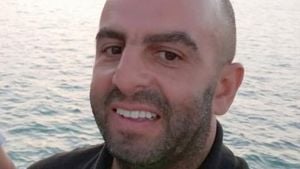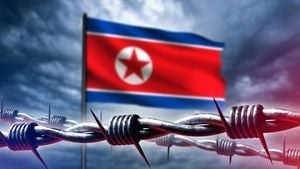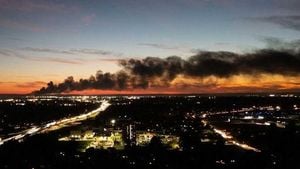Sudan’s civil war, now in its third year, has plunged the country into an ever-deepening humanitarian catastrophe, with the violence reaching new and horrifying levels in recent weeks. The paramilitary Rapid Support Forces (RSF), once partners with the regular Sudanese Armed Forces (SAF) in the country’s attempted democratic transition, have unleashed a wave of attacks across the Kordofan and Darfur regions. The result: mass civilian casualties, mass graves, and a hunger crisis threatening millions.
On Monday, November 3, 2025, the city of el-Obeid in North Kordofan province became the latest flashpoint. According to the United Nations Office for the Coordination of Humanitarian Affairs (OCHA), a drone strike targeted a funeral service, killing at least 40 civilians and injuring dozens more. The attack, which local media blamed on the RSF, comes as the paramilitary force pushes deeper into government-held territory, with the SAF scrambling to mount a defense. As reported by the Sudan Tribune and corroborated by OCHA, the security situation in Kordofan is deteriorating rapidly. "Once again, we call for an immediate cessation of hostilities and for all parties to protect civilians and respect international humanitarian law," OCHA pleaded.
This drone strike is only the latest in a string of atrocities. Just days prior, RSF fighters seized the strategic city of el-Fasher, the capital of North Darfur, after an 18-month siege. The takeover triggered a massacre: over 450 people were killed in a single hospital, with RSF fighters reportedly going room to room, executing civilians and committing sexual assaults. The Sudan Doctors’ Network described the killing of Dr. Adam Ibrahim Ismail, a physician in el-Fasher, as a “heinous crime” targeting medical workers. Ismail was detained during the RSF incursion and killed in a field, a fate that has become all too common for those attempting to provide aid amid the chaos.
Satellite imagery has provided chilling confirmation of the violence’s aftermath. On November 4, analysts at the Yale School of Public Health’s Humanitarian Research Lab, working with the Associated Press, identified mass graves being dug and covered at two sites in el-Fasher. One grave was located near a mosque just north of the Saudi hospital—where the worst of the hospital massacre unfolded—and another by a former children’s hospital repurposed by the RSF as a prison. Earlier satellite images showed white objects—likely corpses—on the hospital grounds and near the children’s hospital, some with visible blood stains. As the Yale report noted, “It is not possible based on the dimensions of a potential mass grave to indicate the number of bodies that may be interred; this is because those conducting body disposal often layer bodies on top of each other.”
Further satellite photos from late October revealed a northern berm outside el-Fasher lined with white objects resembling corpses, as well as burned-out vehicles. Video evidence, analyzed by the Associated Press and other outlets, shows RSF fighters moving among the dead, firing at wounded individuals, and—according to one clip—shooting unarmed prisoners. The RSF has denied responsibility for the killings at the Saudi hospital, but mounting testimony, video, and satellite evidence paint a grimly different picture. The RSF claims to have arrested at least one fighter seen in video footage shooting prisoners, but accountability remains elusive.
As mass graves are filled and bodies are buried, the true scale of the carnage may never be fully known. Poor communications in the region, ongoing fighting, and the RSF’s control of the area make independent investigation nearly impossible. U.N. Secretary-General António Guterres has demanded “mechanisms of accountability” for the atrocities in el-Fasher, stating, “the crimes that are being committed are so horrendous.” Yet, with the RSF firmly entrenched and the region sealed off, justice seems a distant hope.
The violence is not confined to Darfur and Kordofan. The war, which erupted in April 2023 after a falling out between the RSF and SAF leadership, has killed at least 40,000 people according to U.N. figures—though aid groups warn the true toll could be far higher. Over 14 million people have been forced from their homes. In North Kordofan, the town of Bara was recently attacked by the RSF, leaving 47 more dead, including nine women. The Sudan Doctors’ Network expressed horror at the “scene that epitomizes the most grotesque forms of human rights violations and systematic killings.” Survivors report that RSF fighters prevented families from burying their dead, leaving bodies to accumulate in homes.
The humanitarian consequences are staggering. More than 24 million Sudanese now face acute food insecurity, with the World Food Program (WFP) warning of famine in both el-Fasher and the town of Kadugli in South Kordofan. Ross Smith, the WFP’s director of emergency response, told reporters, “We’re seeing very high levels of severe malnutrition and we have many reports of mortality. This is related to conflict for sure.” In some areas, people are going days without eating at all. The fighting has also fueled disease outbreaks, compounding the misery of those trapped by the violence.
With more than a third of the country now under RSF control, the United Nations has labeled the crisis the world’s largest humanitarian disaster. Over 12 million people—nearly a quarter of Sudan’s population—have been displaced, and more than 70,000 fled el-Fasher and its surrounding areas in the days after the RSF takeover. Thousands remain trapped in the city, caught between warring factions and unable to access food, water, or medical care.
The Sudanese government, meanwhile, shows no sign of backing down. Defence Minister Hassan Kabroun announced on November 4 that the SAF would continue its fight against the RSF, even as the country’s Security and Defence Council discussed a U.S.-backed ceasefire proposal. For the civilians caught in the crossfire, such statements offer little comfort. As the war grinds on, calls for peace and accountability grow louder, but the violence shows no sign of abating.
In the shadow of mass graves and empty stomachs, Sudan’s tragedy continues to unfold. The world watches, horrified, as one of the century’s worst humanitarian crises deepens, with no end yet in sight.





